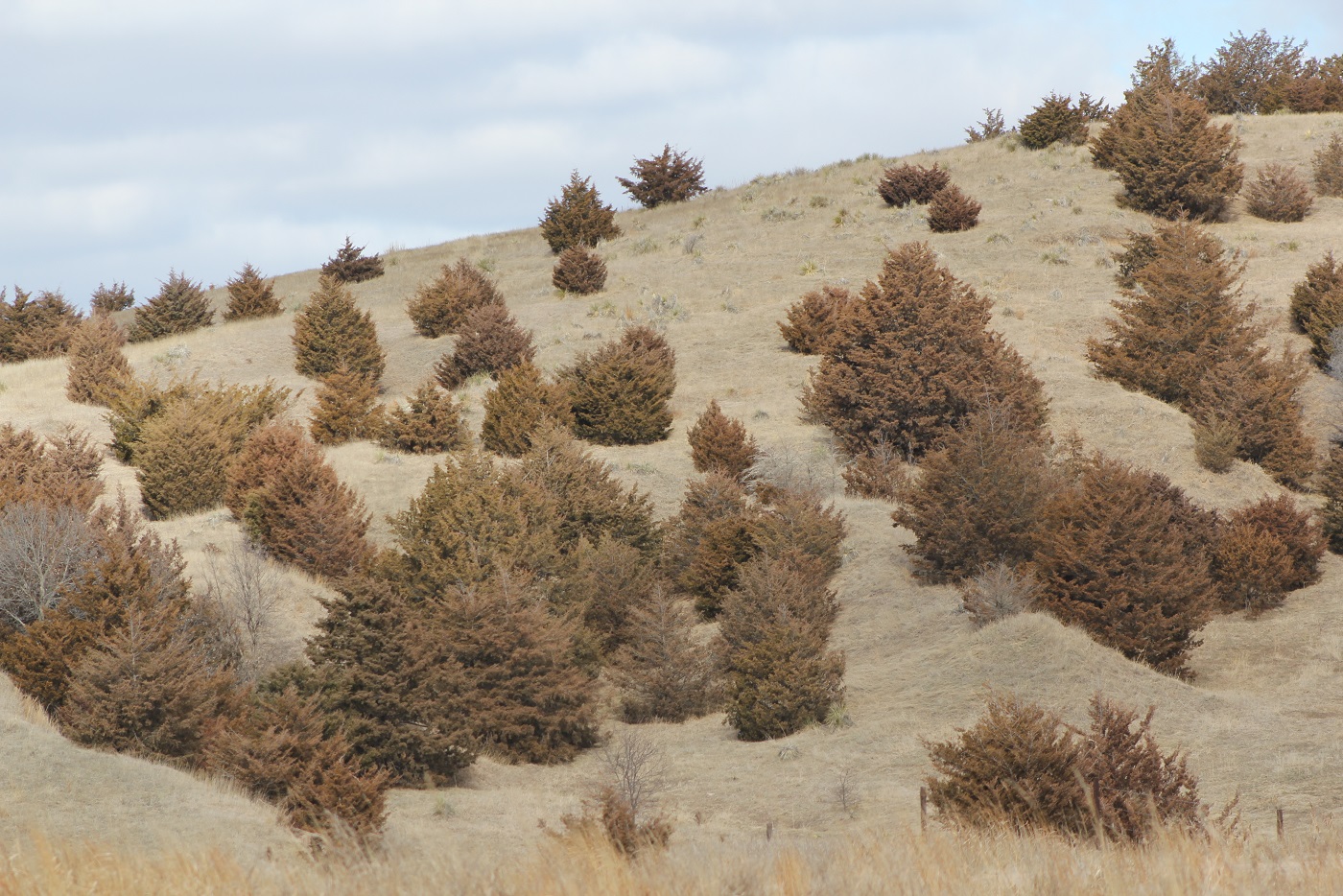
This article was written by students in the University of Nebraska–Lincoln course, AGRO 444—Ecosystem Monitoring and Assessment. Authors are listed at the end of the article.
A reduction in livestock profitability as a result of Eastern redcedar (Juniperus virginiana) invasion poses a major threat to the funding of Nebraska’s public education system.
To understand the consequences of failing to prevent cedar invasion, Nebraskans need only to look south to Texas, Oklahoma, and Kansas where livestock production and profitability has DECLINED 75% where perennial rangelands have been invaded by Eastern redcedar and transformed into cedar woodlands. This invasion is now advancing across Nebraska.
In the last 15 years, the School Land Trust (known formally as the Nebraska Board of Education Lands and Funds) has contributed $573 million to K-12 public schools in Nebraska. The School Land Trust is the largest landowner in the state, receives no State funding, pays county real estate taxes (more than $10,320,000 in 2015), and all of its net revenue goes to K-12 public schools. The Trust owns and manages nearly 1.26 million acres of agricultural land in Nebraska. More than 950,000 acres of Trust land are grasslands that generate income for public schools from grazing leases.
As cedars continue to expand in Nebraska, the School Land Trust has initiated an aggressive campaign to protect grazing revenue and halt cedar invasions onto Trust lands. The Trust first established programs to control cedar in the 1980s. That campaign has been stepped up in the last ten years. The School Land Trust has increased annual expenditures for cedar control by $250,000 since 2006 (Figure 1 http://go.unl.edu/m8vz). Although these expenditures reduce School Trust revenue that would otherwise be distributed to Nebraska’s public schools, the scientific consensus is that such control measures are necessary to prevent catastrophic collapses long-term.
The future trajectory of risk (corresponding to a 75% reduction in grazing profits) is equivalent to an average budgetary loss of $30 million per year over the last 15 years for public education. While it will take decades to reach those losses statewide, the steadily declining profitability will slowly consume school budgets at the rate of a few million dollars a year in the near term. How might this impending disaster be alleviated?
The School Land Trust is now taking steps to remove “the source of the problem”. Two key recommendations have been proposed to the Board: (1) Stop planting cedar trees without special exemptions, and (2) Eliminate seed sources on Trust lands by selectively removing female trees within windbreaks, or removing entire windbreaks.
Even after taking these proactive steps, the Trust relies on landowner stewardship on neighboring lands. The Trust cannot prevent losses in profitability without the removal of seed sources on adjacent lands.
While removing cedar trees is a recommended best management practice for sustainability of beef systems, it represents a major challenge for Nebraska’s citizens. During the last 90 years, hundreds of thousands of cedar seedlings have been distributed from Nebraska’s nurseries each year. Unlike many other horticultural plants that don’t spread from plantings, cedar trees invade surrounding landscapes over time. Birds and mammals can disperse seeds long distances, meaning that cedar trees planted on one person’s property can invade their neighbor’s lands.
Preventing long-term costs to beef production on rangelands requires the removal of redcedar trees, thereby reducing the profits of a producer as a result of decisions made by someone else. In effect, this scenario is playing out on Trust lands. Management efforts have to increase to stay ahead of the increase in seed sources in the surrounding landscape. The unanticipated cost to Nebraskans is a loss of revenue for public education – and these losses will continue to mount as cedars invade additional areas where they were formerly absent or rare.
Authors are:
Diane Lally, University of Nebraska—Lincoln student, Ecosystem Monitoring and Assessment
Christine Bielski, University of Nebraska—Lincoln student, Ecosystem Monitoring and Assessment
Bradley Schick, University of Nebraska—Lincoln student, Ecosystem Monitoring and Assessment
Carter Westerhold, University of Nebraska—Lincoln student, Ecosystem Monitoring and Assessment
Andrew Zahn, University of Nebraska—Lincoln student, Ecosystem Monitoring and Assessment
Craig Allen, Director, Nebraska Cooperative Fish and Wildlife Unit
Bruce Anderson, Professor, Agronomy, Extension Forage Specialist
Dirac Twidwell, Assistant Professor, Rangeland Ecology
To listen to BeefWatch podcasts go to: https://itunes.apple.com/us/podcast/unl-beefwatch/id964198047 or paste http://feeds.feedburner.com/unlbeefwatch into your podcast app.